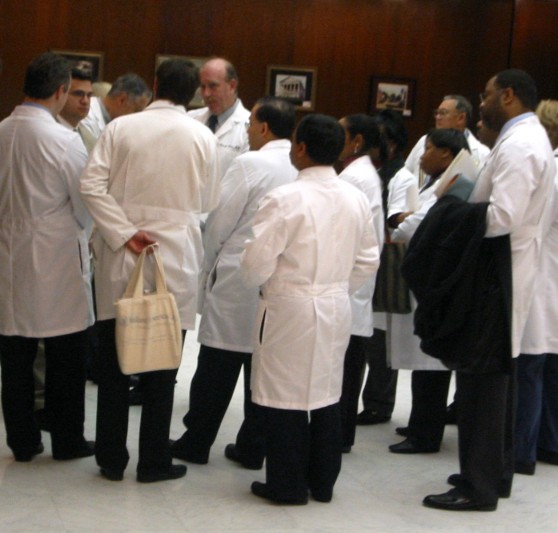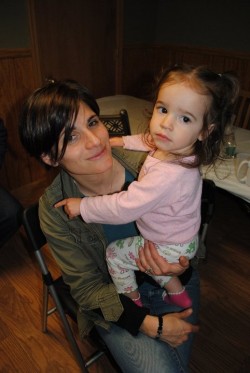Laboring Bodies and Writing Work: The Pregnant First-Year Writing Instructor
The last stage of the laboring society…demands of its members a sheer automatic functioning, as though individual life had actually been submerged in the overall life process of the species and the only active decision still required of the individual were to let go, so to speak, to abandon his still individually sensed pain and trouble of living, and acquiesce in a dazed, ‘tranquilized,’ functional type of behavior. (Arendt 322)
In her three-part theory of the human condition, Arendt describes as “labor” those tasks that must be repeated endlessly to ensure survival. Such efforts support the remaining two components of the human condition, action and work, which for Arendt represent our tide-changing “words and deeds” and the many artifacts made by human hands, respectively. Our work often commemorates or makes possible our action, and neither could exist without our basic source of sustenance, our labor. Still, Arendt’s greatest fear in The Human Condition (1958), as she watched society move into an increasingly machine-driven age, is that laboring might overtake action and work, defining much, if not all, that we do.1 This, for Arendt, is the triumph of the assembly line over human craft, namelessness over the individual. In this essay, I want to use Arendt’s concept of labor as a building block for understanding the particular positioning of the pregnant writing teacher as she functions in two decidedly conflicted, and often misread spaces: the first-year writing classroom and the maternal body. Drawing on Emily Martin’s work in medical anthropology, as well as well-established critiques of first-year writing’s positioning in the university, I will argue that in the pregnant composition teacher we see a dangerously stacked set of circumstances at work upon each other. Enclosed in a body that far exceeds her control, she is a kind of microcosm for the larger system in which she must teach.
Framing Labor: Martin and Arendt for the First-Year Writing Classroom
Published thirty years after Arendt’s work, Emily Martin’s The Woman in the Body: A Cultural Analysis of Reproduction describes medical textbooks’ linguistic treatment of pregnancy, labor, and birth in ways that point at the potential validity of Arendt’s fears realized in the context of maternity. Martin argues that the language of medical textbooks assigns a machine-like functionality to women’s reproductive bodily processes, though she doubts this to be a fair physiological representation. For example, in the medical writing Martin cites, uterine contractions during labor are typically regarded as automatic and beyond the woman’s control; we are essentially given the “uterus-as-machine” (65). At the same time, medical staff assisting the birth typically tell the laboring woman how she is doing, to push harder, or give the unthinkable direction to resist pushing entirely, thus creating a contradictory tension between the uterus-as-machine and the woman-as-laborer or agent in the birth process. According to Martin, the doctor is regarded in the literature as “manager” of the laboring event, providing interventions as needed to keep the uterus/woman machine/laborer on track and as efficient as possible. She writes:
When medical doctors describe the labor that women do in childbirth, their expectations center on how labor of other kinds is organized in our society and how technology and machinery can be used to control those who labor. In both cases women lose, in the first by being overlooked and in the second by having a complex process that interrelates physical, emotional, and mental experience treated as if it could be broken down and managed like other forms of production (65).
Thus, from Arendt and from Martin, we have a concern about the assembly line, whether the machine or the speechless laborer who must be “managed” so as not to impede the process or break the pace. In either case, Arendt’s “individually sense pain and trouble of living” is superseded by the functionality of the process, by “doing” alone.
What I find so compelling about the frameworks that Arendt and Martin provide is that both illustrate a series of core conflicts that are framed through binaries: body versus brain; generic versus particular; doing versus saying. Like most dichotomies, these pairings suggest oversimplification, clean lines where really there are plenty of blurred edges, hierarchy where none exists. But these pairings invite us to think about maternity as it functions in the first-year writing classroom, a space marked undeniably by similar dichotomous divisions given composition’s complex positioning in the university.2 If, as Martin suggests, the “woman in the body” is continuously eclipsed by her physical capacities, so too is the composition instructor potentially overrun by the “machine” that is first-year writing in many universities today.
In his essay, “Knowledge Work, Teaching Work, and Doing Composition,” Christopher Ferry lays bare these tensions as defined by traditional notions of academic knowledge-making:
We read student texts, not ‘great’ texts. We do not write groundbreaking analyses or exegeses but rather responses to these modest efforts. This is what disturbs us most, that compositionists might not be, as Kurt Spellmeyer says, ‘knowledge-workers’ (‘After Theory’ 901), trading in big ideas but instead teamsters, performing the heavy lifting necessary to keep the university afloat. (249)
The role of “keep[ing] the university afloat” echoes Arendt’s definition of labor very clearly and, given the many pressures that compromise first-year writing—from its long-contested “service status,” to the ghettoizing of scholarship that takes root there, to its reliance on exploited laborers—I would argue that Arendt’s worry about the domination of laboring seems very real.3 When labor defines all we do, for Arendt, we lose our capacity to be change agents, innovators, or “knowledge-workers.” In first-year writing, this means staffing classrooms with instructors who lack adequate support and training; it means pushing students through the course despite under-preparedness for college writing; it means dismissing research and scholarship in exchange for too-heavy teaching loads. And all because the machine demands it: there are too many students; too few faculty; not enough sections; a writing program administrator denied tenure because she never had time to write, or because what she did write had as its focus “second-class” content, first-year students and the struggle to teach them.
Given the already-contested nature of the first-year writing classroom, the presence of a pregnant teacher, which is certainly no surprise because women still make up the majority of instructors, brings problematically together two highly conflicted spaces or, two highly conflicted material conditions. Here the “woman in the body,” to borrow Martin’s language, attempts to move within the classroom space and ultimately to articulate and enact a pedagogy against the maternal body that defines her (at least externally), against the intrinsic goals of the first-year course, and against the more mechanistic limitations imposed upon first-year writing by the larger university. When we examine the experience of the pregnant first-year writing instructor, we find a battleground between doing and the ideas that come to life only through words.
In her 2009 essay, “Changing Tables and Changing Culture: Pregnancy, Parenting, and First-Year Writing,” Denise Comer paints a convincing picture of this tension. Referencing Eileen Schell’s work on contingent faculty, mothering, and the teaching of composition, the pressure to be “competent and nurturing” (cited in Comer), she writes:
At times, this physical intimacy can generate the most insidious features of Susan Bordo’s “politics of appearance” (27), where some first-year writing students feel entitled to ask a barrage of seemingly innocuous personal questions that, consciously or not, enable them to situate their pregnant professor within or against a set of perceived cultural norms: Is she married? Is she heterosexual? Did she conceive through intercourse? During the semesters in which I have taught as a visibly pregnant woman, my students have known more about my personal life than in any other semester of my thirteen-year teaching career. They knew more about my personal life than I would have, given the choice, shared. (95)
Here Comer describes a loss of control, where the pregnant instructor finds herself “read” and explored in ways that far exceed her professional boundaries, or even her personal desires. Describing her awareness of “pedagogical shifts,” Comer asks, “Does all of this distraction—the increased physical and emotional intimacy with students, a focus on pregnancy (or children), the visibility of the body—get in the way of the so-called real business of the first-year writing classroom?” (99). I think Comer’s last phrase points tellingly towards the tension she understands well: the first-year writing classroom is often undermined on its own terms, its “business” is already in question. The pregnant instructor thus becomes, compromised by all Comer highlights, the ringleader whose power was always already unstable by virtue of her positioning in two independent spaces: the pregnant body and the first-year composition classroom. The dynamics of these two spaces coming together brings us again to Martin’s depiction of the “managed” birth process, where the goal becomes to keep the pregnant woman out of the way—through interventions and verbal directions—of a process that is defined as out of her control anyway. Applying this model, we can imagine at once the pregnant writing instructor as the “manager” of the first-year class, which itself is driven by the larger material forces that so define it, while she herself undergoes these very same dynamics in the context of her own positioning in the body.4
Stories and Questions: Going Forward in Our Bodies and Classrooms
Of course, we might argue that pregnant bodies face these kinds of challenges wherever they go, and that such systems are far from unique to the first-year writing classroom. While I agree with the argument that pregnant bodies are contested spaces in their own right, I also want to maintain that the first-year classroom is a petri dish filled with its own fertile challenges, staffed by—to revisit Ferry’s words—“teamsters” who are saddled with the work of “keeping the university afloat” while simultaneously denied the status of “knowledge-makers” (249). I approach this contention as someone who has had the good fortune, as a tenured faculty member, to teach concurrently in first-year writing classrooms and advanced-level classrooms while pregnant, including graduate courses.5 I began my faculty position with a five month-old baby, a feat for which the fair hiring practices of my colleagues must be acknowledged (I was about eight months pregnant for my campus visit). As a new mother in my first year on the tenure track, I went to great lengths to portray myself as a professional unfettered by a new infant at home (or, for that matter, a life turned upside-down). Somehow I still batted away surprising questions in the workplace (was I nursing, a senior male colleague wanted to know as I nervously retrieved my mail). About four years later, I taught up until two weeks before the birth of my second child. In the final weeks of my pregnancy, burdened by a diastasis recti (separated abdominal muscles), I frequently had to sit, lost my breath, lumbered painfully and slowly, and had to wear a belt to support the weight of my uterus, which had protruded from between my separated muscles like a hernia. In short, I was a sight to behold and could do little to divert attention from my situation.
At this time, I taught a first-year writing course and advanced undergraduate level courses. The public attention I received in my first-year course was entirely unique to that class, unlike anything I experienced while teaching my other courses. As I took attendance and set up my materials, I had to literally compete with my pregnancy to get the class focused each day, faced with comments about my changing size and shape and even, on one shocking occasion, a question about sexual position and its impact on the sex of the baby. This discussion came exclusively from the women in the class—and women were the majority—but I often felt it alienated the smaller group of male students, whom I perceived to be generally quiet and uncomfortable with the dialogue. I routinely had to aggressively shift students’ focus and often blamed myself for somehow enabling the inappropriate intimacy that happened in that class. During a conference, one of my female students shared with me her decision, at 19, to have a baby with her boyfriend: that she had gotten pregnant just before the start of the semester, and then had miscarried, and that she planned to try again, and, finally, in the last week of our class, that she was, in fact, again pregnant. My status as “pregnant” seemed to assure her that we were equals, women in a shared situation, in ways that undermined my other status: professor who would ultimately would grade her work.
My anecdotal evidence is meant only to open up a series of questions and to point at the tensions around language and material that I see as so embedded in any discussion of pregnant or maternal bodies, and the work we try to do while occupying them. But I want to also insist that first-year writing deserves our particular attention and energy precisely because of its complex positioning in the university and its over-reliance on women to staff its classrooms.6 Accordingly, I end with these questions: To what extent is the teaching of first-year writing defined—or redefined—by the presence of the pregnant teacher? If we agree that the FYW classroom is a particularly contested and potentially problematic space for the pregnant/teaching body, what role might WPAs play in negotiating/supporting mother/teachers? In addition to the classroom space itself, in what ways does the pregnant body complicate the work of writing program administrators in the specific context of the parallel tensions at the heart of both the pregnant body and first-year writing in the university? Lastly, how do we use language to assign value to what we do, to who we are, and thus initiate attitudinal, scholarly, and policy changes? In other words, where do action and words come together in ways that override the worrisome possibility that, really, words alone just might not be enough? I offer this last question with the caution that the theoretical frame I offer in this piece is meant only for the sake of illumination and access. The professional and political challenges posed to the maternal body often demand a step beyond comprehension and into action. Accordingly, my call at the close of this essay is not only for further academic exploration of a complex topic, but also for practical, institutional initiatives to celebrate and support the woman (composition instructor) in the body.
Endnotes
- For further discussion of the relevancy of the “machine age” to the 1950s and, especially, to the “baby boom” which cultural historians have explored in this context, see Wendy Kline’s Building a Better Race: Gender, Sexuality, and Eugenics from the Turn of the Century to the Baby Boom (2005). return
- Far more work than I can list here explores the dynamics of composition’s status in the larger university system; among many important titles, see Sharon Crowley’s Composition in the University: Historical and Polemical Essays (1998) and Bousquet, Scott, and Parascondola’s edited collection, Tenured Bosses and Disposable Teachers: Writing Instruction in the Managed University (2004). return
- I explore these connections in much greater detail in the context of graduate student writing instructors in First Semester: Graduate Students, Teaching Writing, and the Challenge of Middle Ground, published in the Studies in Writing and Rhetoric series by Southern Illinois University Press and the Conference on College Composition and Communication (2012). return
- Here I am reminded of Anne Fausto-Sterling’s well-known Russian nesting doll metaphor meant to describe systems around the “sexed” body, which she establishes in her 2000 book Sexing the Body: Gender Politics and the Construction of Sexuality (253-4). return
- I want to stress here the important distinction Comer—and others—have made between full-time and contingent faculty members; that first-year writing classrooms are more often staffed with contingent and graduate student instructors who are often under-supported, and who lack security of employment, is an important factor in the tensions we find there. return
- See especially the Committee on the Status of Women in the Profession via the Conference on College Composition and Communication. return
Works Cited
- Arendt, Hannah. The Human Condition. Chicago: University of Chicago Press, 1958. Print.
- Comer, D.K. “Changing Tables and Changing Culture: Pregnancy, Parenting, and First-Year Writing.” Composition Studies 37.2 (Fall 2009): 91-113.
- Fausto-Sterling, Anne. Sexing the Body: Gender Politics and the Construction of Sexuality. New York: Basic Books, 2000.
- Ferry, Christopher. “Knowledge Work, Teaching Work, and Doing Composition.” Tenured Bosses and Disposable Teachers: Composition in the Managed University. Eds. Marc Bousquet, Tony Scott, and Leo Parascondola. Carbondale: Southern Illinois University Press, 2004. 242-249. Print.
- Kline, Wendy. Building a Better Race: Gender, Sexuality, and Eugenics from the Turn of the Century to the Baby Boom. Berkeley: University of California Press, 2005.
- Martin, Emily. The Woman in the Body: A Cultural Analysis of Reproduction. 1987. Boston: Beacon Press, 2001. Print.





 Jessica Restaino is Associate Professor and Director of First-Year Writing at Montclair State University. Her book,
Jessica Restaino is Associate Professor and Director of First-Year Writing at Montclair State University. Her book,
I respect the distinction made between pregnancy and all professions, and pregnancy in the context of teaching first-year writing, a decidedly fragile position made all the more vulnerable by the community-property body of the pregnant woman. There are correlations to pregnancy in academia in general, that pile on top of the position of simply being a woman in academia, already swimming against the experience of needing to draw sharp boundaries between our personal lives and our professional. I remember the horror I felt when my colleagues threw me a surprise baby shower; try as I might to act grateful and pleased with their thoughtfulness, mostly I was just embarrassed and trying to minimize the idea that I was now a “mother,” not a colleague. The entire hour was awkward as I deflected well-meaning questions: did we know the sex? Had we picked out names? Were we going to have more?
I had already experienced the crossing of lines as a young history teacher; in a department of older male teachers, I was the only woman, and a novelty to the students. They felt emboldened by my outgoing style and youth, to ask: did I have a boyfriend? Did I drink or do drugs in college? How old was I? Did I have tattoos?
I think what I take away from both my experience and your essay is the idea that, while we embrace and take pride in the miracle of creating new life and our shifting identity personally, we risk being reduced to merely that in the classroom, and in our professional identity – not just by students, but by our colleagues. I appreciate your raising these questions and sharing the issue as it pertains to the uniquely undervalued first-year writing instructor.
Thanks for your thoughtful insights here, Julie–much, much appreciated. Thanks, too, for sharing your experience of the professional-context-baby-shower. I get it, totally. It’s in these moments that we basically doing battle–in an odd way–with the ways in which the pregnant body is assigned (commands? receives?) sets of cultural readings and mores which can easily exceed or even contradict the wants and needs of the person in the body, ie woman-as-professional, woman-as-teacher, and so on. Let’s keep this conversation going! Jess
Great piece, Jess. Thanks. It hadn’t occurred to me until reading it that there’s a kind of analogy between the pregnant woman, a riddle in nine months, and the writing instructor, a riddle in fourteen weeks—both charged with managing a process that they’re never quite granted full control over.
Although, come to think of it, I do remember a conversation, several years ago, with a colleague who was returning to full-time teaching after giving birth to and raising two small children. She said to me, “I feel like I’ve been working in the service of the species, not the profession.” In a darkly comic way, that remark seems to gesture toward the connection you make (and question) here.
I was also glad to see you draw on the work of my colleague Denise Comer. As I read her piece, the key point is that the “problem” of pregnant women in the writing classroom is not one that can be solved simply through instituting better policies but that also needs to be addressed through changes in our professional culture and attitudes.
And, finally, I was intrigued by Ferry’s metaphor of the writing teacher as teamster—which seems shift our thinking in terms of gender and maybe even class. I’d be curious to learn more about how you think that metaphor fits (or conflicts) with the issues and attitudes you discuss here.
Thanks again!